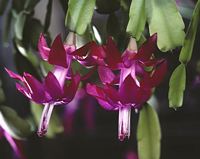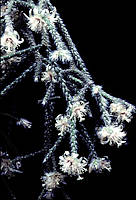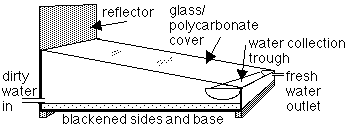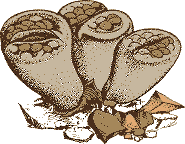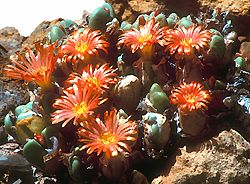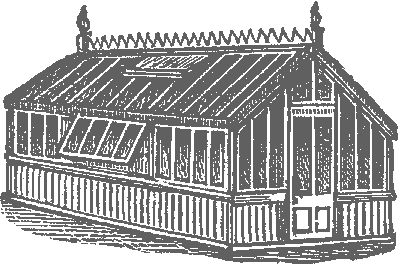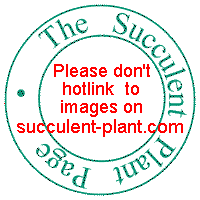
 
The Cultivation Page
Quick Tips
Whatever the size of your collection of succulent plants, I hope that you find the following hints and tips useful. This information is of a general nature, based on the accumulated experience of many growers. However, the owner of this page cannot accept liability for any plant loss, or damage, or personal injury arising from use of this information.
|
|||||||||||||||||||||||||||||
My own mixture:As an example, my own potting mixture is based on sieved compost made from vegetable kitchen waste and leaves, weeds and other waste from the garden. This material accumulates and decomposes in a large green 4 ft tall plastic composter, obtained from the local council for a small fee.
| ||||||||||||||||||||||||||||
 Soil pH
Soil pH
. . . more about
soil pH
Most cacti and succulent plants prefer a slightly acidic compost (pH6). If in doubt, this is the best choice for most species, but also avoid watering with strongly alkaline tap water. Simple, affordable pH meters are sold in many garden centres.
Some species e.g. Echevierias really hate lime and are probably suited to a peat-based compost. Others e.g. Ariocarpus fissuratus, Echinocactus horizothalonius, Escobaria tuberculosa always seems to grow on limestone in their habitat and may appreciate a proportion of ground limestone or dolomite of lime in their growing medium. Still other plants e.g. Geohintonia are noted for growing on nearly pure gypsum cliffs.
Ground limestone is calcium carbonate with a mild alkaline reaction neutralising soil acids.
Dolomite of lime is a mixture of calcium and magnesium carbonates with a mild alkaline reaction.
Gypsum is calcium sulphate, neither acidic nor basic.
Garden Lime is calcium hydroxide and has too strong an alkaline reaction for use in potting mixtures.
 Repotting a prickly customer
Repotting a prickly customer
Ideally, succulent plants should be re-potted every year to provide fresh compost and room to grow. This is also an ideal time to inspect the roots for diseases such as root mealy bug.
A good way of handling spiny cacti or spiny euphorbias during repotting without breaking the spines is to wrap a roll of newspaper or paper towel round the sides of the plant. This may be kept in place if required by elastic bands or a wire twist tie. If the spines become entangled, wetting the paper will make it easier to remove, and small bits can be taken off the spines with tweezers. 'Old hands' often handle plants with bare hands during repotting by distributing the weight on the hands between as many spines as possible. However, this is not recommended with Opuntia sp. as the fine spines (glochids) will break off and become embedded in the skin, or with Mammillaria species with 'fish-hook' spines that tend to catch in the skin.
To re-pot, invert the plant and tap the rim of the pot against the bench or with a piece of wood to loosen the pot from the compost. Inserting a piece of cane into the hole in the pot may help this process, but beware of damaging plants with fleshy or tuberous roots. If the plant is in a plastic or other flexible pot, squeezing the pot gently may help to loosen the root ball. As a last resort, it is better to break the pot to free a compacted root ball rather than damage the plant.
Remove the pot and clear away the old compost from the roots, keeping an eye out for pests. Use a thin stick or plant label to tease out the roots and remove old soil. If you see white fluffy patches in the soil and tiny insects, similar in shape to woodlice, but about 2 mm long these are root mealy bugs. If you find any pests, remove or wash off as much soil as possible, and soak in systemic insecticide. I used to use a formulation containing dimethoate but this is now unobtainable. One based on imidacloprid which is less toxic to plants and people was very effective, but also hard to come by. Newer Neonicotinoid insecticides can be tried but seem less effective to me.
Repot the plant into a new pot, which should be a little larger than the old one (perhaps 1 cm extra all round) if the plant has grown to fit its old pot. Replace fairly dry new compost around the roots and allow the plant to rest for about two weeks before watering to allow broken roots to heal.
 Handling Euphorbias
Handling Euphorbias
The Euphorbiaceae comprise a fascinating group of succulent and non-succulent plants, with a wide range of growth forms and sizes, and are well worth growing. However, the milky latex characteristic of plants in this group is very poisonous and should be treated with respect. Euphorbia latex should never be allowed to come into contact with the eyes and any contamination should be washed off the skin immediately. It is a good idea to make a habit of washing one's hands with soapy water immediately after handling or re-potting any Euphorbia species.

|


 Plenty of bright light e.g. sunny window ledge.
Plenty of bright light e.g. sunny window ledge.
